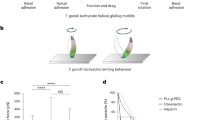Abstract
IT is well known that in numerous Protozoa, the contractile vacuole is associated with an osmiophile cortex, which is believed to be homologous with the Golgi apparatus of metazoan cells. In Paramecium, it has been shown by Nassonow1 that the secretory canals leading into the contractile vacuoles are osmiophilic in nature, and are considered to represent the Golgi apparatus in this form. Although many Protozoa possess similar canalicular systems, canals with osmiophile walls have never since been demonstrated in any other Protozoon, although a great number have been investigated.
This is a preview of subscription content, access via your institution
Access options
Subscribe to this journal
Receive 51 print issues and online access
$199.00 per year
only $3.90 per issue
Buy this article
- Purchase on SpringerLink
- Instant access to full article PDF
Prices may be subject to local taxes which are calculated during checkout
Similar content being viewed by others
References
Nassonow, D., Arch. Mikr. Anat., 103 (1924).
Gatenby, J. B., and Smyth, J. D., Quart. J. Micro. Sci., 81 (1940).
Author information
Authors and Affiliations
Rights and permissions
About this article
Cite this article
SMYTH, J. Golgi Apparatus in Astasia Harrisii. Nature 151, 110 (1943). https://doi.org/10.1038/151110a0
Issue date:
DOI: https://doi.org/10.1038/151110a0



